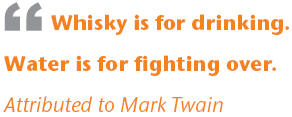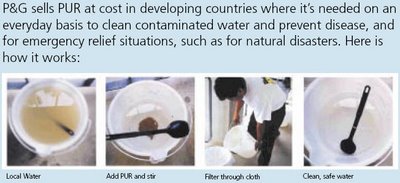Safe Water Technology: PUR by Proctor & Gamble

 As alluded to in an earlier post, safe drinking water and water availablity are enormous issues.
As alluded to in an earlier post, safe drinking water and water availablity are enormous issues.
“Well over 2 billion people drink sewage contaminated water”– Dr. Steve Luby, CDC. And you can see from the graph that availabilty is decresasing in dramatic fashion. This month the World Business Council for Sustainable Development updated their case studies for water related issues. They released what looks to be quite a decent report here. Also the new case study on water is a point of use water solution by Procter & Gamble (P&G) which you can find here along with other case studies.
The P&G approach uses a “point of use” solution meaning that this may have “advantages of cost, immediate availability and ease of distribution to reach rural areas.” When I first saw this my first reaction from the WBC for Sustainable Business was how sustainable is this? What is the mechanism for distribution and what are the long term plans. It looks like, in conjunction with NGO partners, they are going to try three different approaches:
1. A social model led by non-profit organizations
2. A commercial model led by the private sector
3. An emergency relief model led by relief organization
I hope these approaches are in different areas or the models may cannibalize each others markets and incentives for private sector buying. Giving something away for free is not necessarily a good thing, it prevents local entrepreneurs from developing small businesses and hence potential long term sustainability. This is not always the case, but it is something to be aware of.
So what is the PUR SOLUTION? The technological innovation here is a detergent like mixture from Procter & Gamble. “PUR acts like a dirt magnate it, it pulls the dirt out of the water and removes the bacteria, viruses and the parasites and leaves behind clear, safe, drinkable water” – P&G. (quotes from this 1 min video). You can view the short video or you can see below a diagram of how it works:
In conjunction with this case study, last month there was a press release indicating Procter and Gamble’s committment to this area. “P&G committed to providing 35 million liters of safe drinking water to more than 1 million children… As part of this announcement, P&G has committed to provide $3.8 million to a variety of partners in order to provide safe drinking water in Africa.” Full press release here.
In a future post we will cover sustainable point of use water technologies being developed by folks at UC Berkeley to give a different perspective.

[…] several large MNCs have shown an active interest in clean water in developing countries (e.g., Procter and Gamble, Vestergaard Frandsen, Dow) open questions remain as to what role large MNCs will play in providing […]
Milwaukee: hub of water technology in global health? « Technology, Health & Development
March 31, 2009 at 11:57 am
[…] 700 liters of water at 2 liters per day and thus lasts a year. Proctor and Gamble is working on PUR in the clean water […]
The Next Four Billion and the Base of the Pyramid (BOP) « Compassion in Politics: Christian Social Entrepreneurship, Non-Profit Organizations, and Base of the Pyramid Design Solutions
March 17, 2009 at 11:48 pm
[…] Dr. Allgood presented Procter & Gamble’s (P&G) work on PUR, a point-of-use water treatment system (PUR was dicussed in an earlier post). As a flocculant-disinfectant, PUR is able to clean even heavily sedimented (turbid) water – the flocculant causes the sediment to coagulate, while the disinfectant kills harmful organisms. This project has led to 2 siginificantly new business practices for P&G: (1) considering emergency relief as a market, and (2) letting an NGO manage a P&G brand. As a consumer products company, Dr. Allgood indicated a key strength of P&G is understanding people and their relation to products such as PUR. As an example, inside the household, they have observed “water segmentation” – their product is used primarily for the most vulnerable, young children, the elderly, and PLWHA (People Living With HIV/AIDS). […]
Private Sector & Public Health « Technology, Health & Development
November 13, 2006 at 1:43 pm